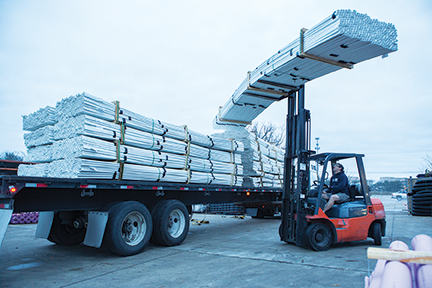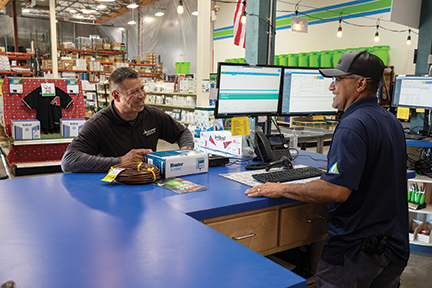Start now to navigate 2022 supply chain challenges successfully.

As the world prepares to navigate a third spring and summer impacted by fallout from the Covid pandemic, green industry professionals in the U.S. should brace themselves for the challenges ahead. Gone for the foreseeable future are the days when landscape contractors could book a job knowing for certain they could simply pull up to their favorite distributor’s warehouse, load up everything they need, and head to the jobsite to get started.
Foreign supply side issues, production delays, port congestion, fuel and freight costs, natural disasters, and a shortage of materials, equipment, and workers are all expected to continue well into 2022 and perhaps beyond. Add skyrocketing demand, and the challenges become even greater, but they are not insurmountable if you plan ahead.
Ewing Irrigation & Landscape Supply’s product management team has always paid close attention to the global supply chain and to events that impact availability of materials, supplies, and equipment. In June 2021, Ewing began putting supply chain updates online to help contractors understand the ever-changing state of the industry, provide them with the necessary information to plan projects, and allow them to communicate with their clients.
For 2022, here are some of the top things landscape contractors should keep in mind.
Top Shortages
While it’s impossible to fully predict what will happen in the future, the following product categories are expected to be heavily impacted in 2022:
- PVC pipe
- Chemicals
- Hardscapes
- Select electronic components
Two examples of products impacted by short supply and high demand are the herbicide glyphosate and fertilizer. As of late fall 2021, glyphosate prices were up as much 300% over 2020, and fertilizers prices rose to record levels. Extreme weather in the U.S. and abroad, power outages in China and Europe, pre-pandemic environmental regulations in China and India that shuttered factories, continuing Covid lockdowns, higher natural gas prices, increased shipping costs, and an industrywide shortage of truck drivers will likely continue to have repercussions on those categories and other hard-hit product categories in 2022.

Inflation in the U.S. rose to nearly 7% in 2021, its highest rate since 1982. It’s expected to remain high due to robust product demand and continuing supply chain issues. Rising fuel, materials, and labor costs have impacted—and will continue to impact—every industry sector. As a result, the cost of doing business in 2022 is expected to continue going in one direction: up.
What does all of this mean for landscape business owners? It’s uncomfortable, but the reality is that everyone must take a hard look at their bottom line and adjust accordingly to keep their businesses healthy. Those who haven’t already evaluated their pricing should do it now. In addition to the services to be provided, and the labor, equipment, materials, and supplies needed to do each job, it’s critical to factor in the location of each jobsite. The further the drive, the easier fluctuating fuel costs can quickly turn expected profit into a loss.
It’s also uncomfortable to think about walking away from jobs, but that’s something business owners also must consider. Don’t be afraid to pass on projects that aren’t profitable or won’t help your business grow.
6 Tips To Keep Projects Moving
While ongoing supply chain issues will continue to challenge landscape contractors as they decide what, how much, when, and where to buy materials and supplies for projects, the good news is you’re not alone. Distributors are happy to share their industry knowledge as well as their strategies for success.
Here are six tips to help keep your projects moving, your clients happy, and your business healthy in the coming year:

- Work closely with your distributors. Account managers and branch professionals know what’s in stock and what’s incoming, and they are happy to suggest alternatives if your usual product is not available. If you haven’t established close relationships with your distributors, reach out and get started. Many account managers will communicate with their customers weekly, and more often when needed.
- Communicate regularly with clients and work crews. We’ve all heard the saying, “don’t over-promise and under-deliver.” By staying on top of what’s available and keeping clients and work crews in the loop, you build trust and help projects run more smoothly. Provide everyone with a clear picture of what’s happening.
- Keep quote windows relatively short. Aim for between 15 and 30 days. By now, most consumers understand that prices can change quickly and fluctuate wildly, and that booking early can help avoid backlogs.
- Don’t delay ordering. As soon as you book a job, even if your start date is weeks away, place your order with your distributor. Arrival of incoming product varies depending on several factors—including where it’s coming from and how it’s getting to your distributor’s warehouse. The earlier your distributor knows what you need, the easier it will be for them to fulfill your order, and the easier it will be for you to start and complete projects.
- Build inventory strategically. Instead of going into “panic-buy” mode and buying skids and skids of product in hopes you’ll need it for jobs you haven’t yet booked, consider a more strategic approach. Look at what you have on hand, then compare it to what you need for existing jobs and what you anticipate you will need for new services and clients. Talk with your distributor and let them help you with strategies to put your plans into motion.
- If you prefer to buy months in advance, extend your payments. If you’re comfortable taking on more aggressive stock levels for projects scheduled throughout the entire year, ask your distributor for extended payment terms to help manage cash flow. Many distributors offer several credit options, as well as loyalty rewards programs that can help you stretch your purchasing power.
York is Director of Product Line Management for Ewing Irrigation & Landscape Supply, supporting the company’s more than 230 locations nationwide.Representing the fourth generation of family leadership, York leads Ewing’s product management efforts, including working with product managers on vendor relations, sales, and marketing strategies.
Ewing has weathered many economic challenges over the course of its 100 years in business and is ready to help. Look for Ewing Supply chain updates here.











![[VIDEO] Dickies®: Discover Workwear That’s Anything But Uniform](https://turfmagazine.com/wp-content/uploads/2023/06/1647663814-4b1a2a7742790a9b1e97a3b963477850192e1d6a9dfba9b07214a77bae25d6e3-d-218x150.jpg)





























![[VIDEO] Dickies®: Discover Workwear That’s Anything But Uniform](https://turfmagazine.com/wp-content/uploads/2023/06/1647663814-4b1a2a7742790a9b1e97a3b963477850192e1d6a9dfba9b07214a77bae25d6e3-d-324x160.jpg)